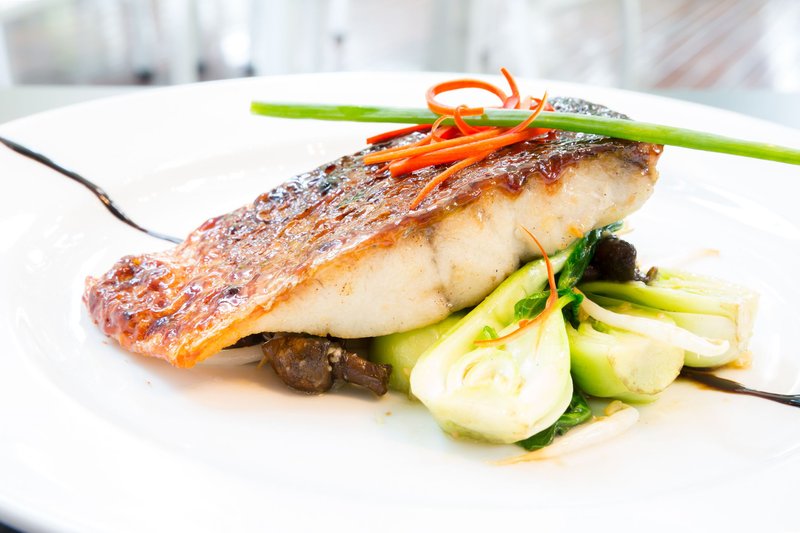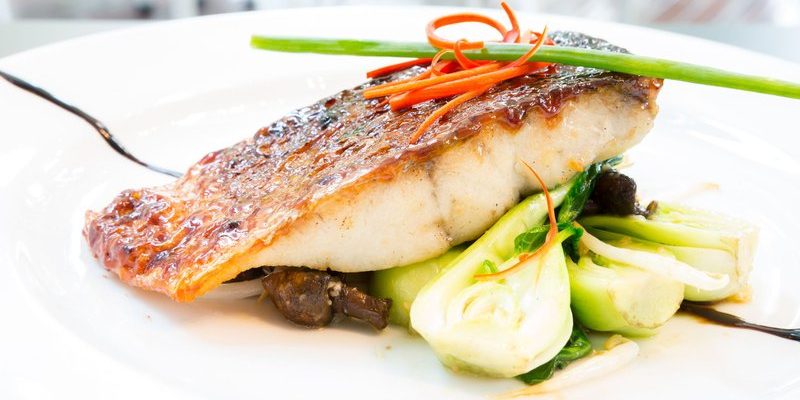
The barramundi, often referred to as the “silver perch” or “Asian sea bass,” is a remarkable fish that captivates both anglers and seafood lovers alike. You might be picturing a sleek, shimmering creature gliding through warm waters — and you’d be absolutely right! This fish is not just a culinary delight; it holds cultural significance in many parts of Australia and Southeast Asia.
With a name derived from the Aboriginal word meaning “large scale,” the barramundi boasts a unique combination of flavor and versatility. Its firm, white flesh makes it a favorite choice for grilling, frying, and baking. But beyond its tasty meat, the barramundi has an interesting life cycle, habitats, and behavior that make it a true marvel of aquatic life. So, let’s dive in and explore all the incredible aspects of this incredible fish!
Physical Characteristics of Barramundi
Barramundi are easily recognizable thanks to their striking features. Typically, they have a streamlined body covered in large, shiny scales, which allows them to move gracefully through the water. The fish can grow quite large, often reaching lengths of up to 1 meter (3.3 feet) or more, with weights averaging around 10-30 kg (22-66 lbs). Their coloration ranges from a silvery hue to darker shades, especially on their backs, which provides effective camouflage against predators.
One of the fascinating things about barramundi is their ability to change color based on their environment. This flexibility not only helps them avoid unwanted attention but also aids them in hunting. Barramundi have sharp teeth and strong jaws, making them formidable hunters. They primarily feed on smaller fish and crustaceans, showcasing their predatory nature.
What’s even more intriguing is their reproductive adaptation. Barramundi are protandrous hermaphrodites, meaning they start their lives as males and may later become females as they age. This unique trait ensures that populations remain healthy and robust, allowing for successful breeding opportunities. Imagine a fish that grows and changes its role throughout its life – how cool is that?
Habitat and Distribution
Barramundi are native to the Indo-Pacific region, commonly found in the coastal waters of Australia, Southeast Asia, and even parts of the Indian Ocean. These fish thrive in various environments, including estuaries, rivers, and the open ocean. They particularly favor mangrove swamps and freshwater systems, where they can find ample food and suitable breeding grounds.
During their early life stages, barramundi often reside in brackish waters, where the blend of fresh and saltwater creates an ideal habitat. As they mature, they venture into deeper waters, showcasing their adaptability. This ability to thrive in different environments serves as a testament to their resilience, allowing them to survive in various conditions.
Interestingly, barramundi are also known for their migratory behavior. They will often travel long distances between spawning and feeding grounds, which can sometimes be over 100 kilometers (62 miles). This adaptability not only helps them find food but also ensures they can reproduce effectively. With such a broad distribution, it’s no wonder that barramundi are highly sought after in fisheries across the globe.
Diet and Feeding Habits
When it comes to diet, barramundi are opportunistic feeders, meaning they’ll eat whatever food is available. Their primary diet includes small fish, crustaceans, and even insects. This diet is rich in protein, which helps them grow quickly and maintain their impressive size. Imagine a fish that can outsmart its prey with speed and agility — that’s barramundi for you!
Young barramundi primarily feed on plankton and small aquatic insects, which help them develop the necessary skills for hunting larger prey as they grow. As they transition from juveniles to adults, their diet shifts to include larger fish like mullet and other smaller species. Their keen eyesight and sharp senses make them effective predators, allowing them to stalk and ambush their meals with precision.
Barramundi also have a unique feeding strategy that involves hunting in packs. This social behavior increases their chances of catching prey, as they can work together to corner and overwhelm fish. Think of it as a well-coordinated team effort — how impressive is that? This collaborative approach undoubtedly contributes to their success as a species, giving them the edge they need in their aquatic environment.
Life Cycle of Barramundi
The life cycle of barramundi is a captivating journey that begins in estuarine environments, where they spawn in large numbers. Females can lay up to 30 million eggs during a single spawning event, ensuring that enough offspring survive to adulthood. These eggs then hatch into tiny larvae known as “fry,” which drift with tidal currents into protected brackish waters.
As they grow, barramundi go through several developmental stages, progressing from fry to fingerlings and eventually to juveniles. During their early life, they are vulnerable to predation, but once they reach about 10 cm (4 inches), they become more resilient. This growth phase typically lasts several months, depending on environmental conditions and food availability.
Once they reach maturity, barramundi can live for up to 10-20 years, although some individuals may live longer. Their transition from male to female is particularly fascinating, as older males may become females when the population demands it. This unique reproductive strategy not only helps maintain healthy populations but ensures genetic diversity within their species, allowing barramundi to thrive in various environments.
Conservation Status and Threats
While barramundi are not currently considered endangered, they do face several threats, especially from fishing pressures and habitat loss. Overfishing can lead to declining populations, making it essential to implement sustainable fishing practices. Organizations and governments in Australia and Southeast Asia have recognized the importance of responsible fishing to maintain healthy barramundi populations.
Habitat loss, particularly due to coastal development and pollution, poses another significant threat. Mangroves, which are crucial for juvenile barramundi, are being destroyed for urbanization and agriculture. Protecting these vital ecosystems is essential for the future of barramundi and many other species that rely on them for survival.
To help conserve barramundi populations, initiatives such as fishery regulations and habitat restoration projects are in place. These programs aim to ensure that future generations can continue to enjoy the beauty and benefits of barramundi, both in the wild and on our plates. By supporting sustainable practices, we can all contribute to the preservation of this remarkable fish.
Culinary Appeal of Barramundi
Barramundi has become a staple in many restaurants and kitchens around the world, thanks to its mild flavor and flaky texture. Its versatility makes it suitable for a wide array of cooking methods, from grilling and baking to frying and steaming. If you’re curious about how it tastes, think of a delicate white fish with a slightly sweet undertone — delicious!
The fish is popular not just because of its flavor but also due to its health benefits. Barramundi is rich in omega-3 fatty acids, which are essential for heart health and brain function. Plus, it’s a lean source of protein, making it an excellent choice for those looking to maintain a healthy diet. You can feel good about enjoying a meal that’s both tasty and nutritious!
Another appealing aspect of barramundi is that it’s often farmed sustainably. Many fish farms are committed to environmentally friendly practices that ensure the fish are raised in clean waters and fed a balanced diet. This commitment to sustainability is great news for consumers who want to make informed choices about the seafood they enjoy.
Interesting Facts About Barramundi
| Scientific Name: | Lates calcarifer |
| Size: | Up to 1 meter (3.3 feet) long |
| Weight: | Average 10-30 kg (22-66 lbs) |
| Habitat: | Coastal waters, estuaries, rivers |
| Lifespan: | 10-20 years |
| Diet: | Small fish, crustaceans, insects |
| Spawning: | Can lay up to 30 million eggs |
From their impressive size to their culinary appeal, barramundi truly is a captivating fish. They play a vital role in their ecosystems and have become a cherished part of many cuisines around the world. As we continue to enjoy this delightful fish, it’s essential that we also recognize our responsibility to protect and preserve the environments they inhabit. By doing so, we ensure that this magnificent species remains a part of our oceans and our plates for generations to come.
FAQ
What does barramundi taste like?
Barramundi has a mild, slightly sweet flavor that many describe as delicate. Its flesh is firm yet flaky, making it easy to cook and versatile for various recipes. Whether grilled, baked, or fried, barramundi often absorbs flavors beautifully, making it a favorite in many culinary traditions.
Are barramundi safe to eat?
Yes, barramundi is considered safe to eat and is rich in omega-3 fatty acids, which are beneficial for heart health. It’s important to source your barramundi from sustainable fisheries or farms to ensure the fish is raised in healthy environments and free from harmful contaminants.
How do you cook barramundi?
Cooking barramundi is quite simple due to its mild flavor and flaky texture. You can grill, bake, steam, or pan-fry it. A popular method is to season it with herbs and spices and roast it in the oven until it flakes easily with a fork. Pair it with fresh vegetables or a citrus sauce for a delightful meal.
How can I ensure I’m buying sustainable barramundi?
To ensure you’re purchasing sustainable barramundi, look for labels or certifications from recognized organizations that focus on responsible fishing and aquaculture. Additionally, local fish markets or reputable grocery stores often provide information about their sourcing practices. Knowing where your fish comes from is crucial for making environmentally conscious choices.
Can barramundi be farmed?
Absolutely! Barramundi can be farmed successfully, and sustainable aquaculture practices are being implemented in many regions. This method helps meet the rising demand for this delicious fish while minimizing the impact on wild populations. Farmed barramundi can be a great choice for consumers who want to support sustainable seafood options.
What are common cooking methods for barramundi?
Common cooking methods for barramundi include grilling, baking, pan-searing, and steaming. Each method highlights the fish’s natural flavor and texture. Grilling is particularly popular for outdoor gatherings, while baking can infuse the fish with additional flavors from herbs and spices.
Is barramundi a seasonal fish?
Barramundi are available year-round due to their wide distribution and the ability to farm them. However, their peak season may vary by region, especially in wild fisheries. When buying fresh barramundi, check local availability and any seasonal considerations for the best quality.
Where can I find barramundi?
You can find barramundi in many grocery stores, seafood markets, and restaurants that serve fresh fish. It’s popular in regions where it is native, especially in Australia and parts of Southeast Asia. If you’re in a landlocked area, you might find it in the frozen seafood section.
What are the environmental concerns surrounding barramundi fishing?
Environmental concerns regarding barramundi fishing include overfishing and habitat destruction. Sustainable fishing practices are crucial to maintain healthy populations. Additionally, preserving mangrove habitats, where juvenile barramundi thrive, is essential for the long-term survival of the species.
Can barramundi be kept in aquariums?
While it’s possible to keep barramundi in aquariums, they require a significant amount of space due to their size and swimming nature. Barramundi are not commonly kept as aquarium pets, but if you have a large enough setup with proper filtration and care, it can be a rewarding experience to observe them in a controlled environment.
What should I serve with barramundi?
Barramundi pairs well with a variety of sides, including roasted vegetables, rice, or a fresh salad. You can also enhance your meal with light sauces, such as citrus or herb-infused vinaigrettes, which complement the fish’s delicate flavor beautifully.

